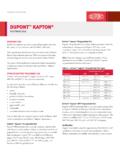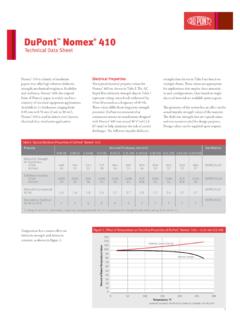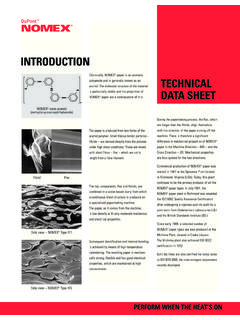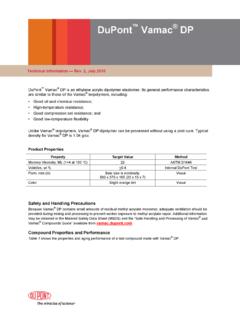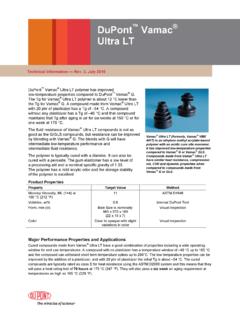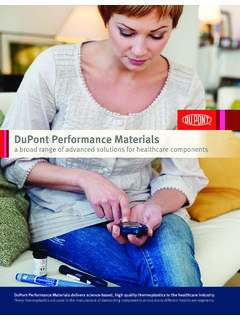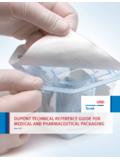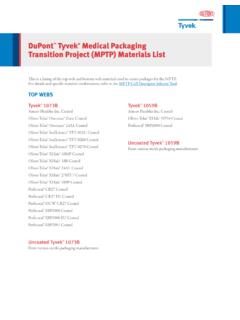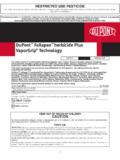Transcription of DUPONT KAPTON FPC
1 TECHNICAL DATA SHEETDuPont KAPTON FPC polyimide film is treated on both sides and has the same excellent balance of physical, chemical and electrical properties over a wide temperature range offered by general purpose KAPTON HN. KAPTON FPC offers superior dimensional stability and adhesion, and is specifically designed for flex circuit manufacturers. Adhesion data for FPC can be referenced in the adhesion to KAPTON technical applications where superior adhesion and low shrinkage are important, KAPTON FPC is the polyimide film of KAPTON FPCPOLYIMIDE FILM Flexible printed circuits Automotive Computers Consumer products Telecommunications equipment Industrial instrumentation and controls Military applications Aerospace Electronic parts PCB stencils Screen printing Insulation tubingTable 1 Typical Properties of KAPTON FPC at 23 C (73 F)
2 PropertyUnit1 mil 25 m2 mil 50 m3 mil 75 m5 mil 125 mTest MethodPhysicalTensile Strengthkpsi (MPa) (231)34 (234)34 (234) (231)ASTM D-882-91 Elongation%72727882 ASTM D-882-91 Tensile Moduluskpsi (GPa)400 ( )400 ( )400 ( )400 ( )ASTM D-882-91 Adhesionpli (N/mm)10 ( )10 ( )10 ( )10 ( )IPC-TM-650 Method * D-1505-90 MIT Folding Endurancecycles285,00055,0006,0003,000 ASTM D-2176-89 Tear Strength-propagating (Elmendorf ), D-1922-89 Tear Strength, initial (Graves), D-1004-90 ThermalFlammability94V094V094V094V0UL-94 Shrinkage (30 min at 150 C)% Oxygen Index%37434645 ASTM D-2863-87 ElectricalDielectric StrengthkV/mil (kV/mm) (303) (240) (201) (154)ASTM D-149-91 Dielectric D-150-92 Dissipation Factor at 1 D-150-92*Acrylic adhesive to 1 oz.
3 CopperAPPLICATIONSPRODUCT SPECIFICATIONSK apton FPC is manufactured, slit and packaged according to the product specifications listed in H-38487, Bulletin FPC meets IPC 4202/1 KAPTON FPCT able 2 Physical Properties of KAPTON FPC FilmPhysical PropertyTypical Value atTest Method23 C (73 F)200 C (392 F)Yield Point at 3%, MPa (psi)69 (10,000)41 (6000)ASTM D-882-91 Stress to produce 5% elonga- tion, MPa (psi)90 (13,000)62 (9000)ASTM D-882-91 Impact Strength, N cm (ft lb)78 ( ) DUPONT Pneumatic Impact TestCoefficient of Friction, kinetic (film-to-film) D-1894-90 Coefficient of Friction, static (film-to-film) D-1894-90 Refractive Index (sodium D line) D-542-90 Poisson s three samples Elongated at 5%, 7%, 10%Low Temperature Flex LifepassIPC-TM 650, Method 3 Thermal Properties of KAPTON FPC FilmThermal PropertyTypical ValueTest ConditionTest MethodMelting PointNoneNoneASTM E-794-85 (1989)Thermal Coefficient of Linear Expansion20 ppm/ C (11 ppm/ F)-14 to 38 C (7 to 100 F)ASTM D-696-91 Coefficient of Thermal Conductivity, W/m-Kcal_____cm sec x 104296 K 23 CASTM F-433-77 (1987)Specific Heat, J/g K (cal/g C) ( )
4 Differential calorimetryHeat Sealabilitynot heat sealableSolder FloatpassIPC-TM-650, method GenerationDm=<1 NBS smoke chamberNFPA-258 Glass Transition Temperature (Tg)A second order transition occurs in KAPTON between 360 C(680 F) and 410 C(770 F) and is assumed to be the glass transition temperature. Different measurement techniques produce different results within the above temperature 4 Electrical Properties of KAPTON FPC Film at 23 C (73 F)Property Film GageTypical ValueTest ConditionTest MethodDielectric Strength 25 m (1 mil)50 m (2 mil)75 m (3 mil)125 m (5 mil)V/m kV/mm303240201154(V/mil)(7700)(6100)(510 0)(3900)60 Hz 1/4 in electrodes 500 v/sec riseASTM D-149-91 Dielectric Constant25 m (1 mil)50 m (2 mil)75 m (3 mil)125 m (5 mil) kHzASTM D-150-92 Dissipation Factor 25 m (1 mil)50 m (2 mil)75 m (3 mil)125 m (5 mil)
5 KHzASTM D-150-92 Volume Resistivity 25 m (1 mil)50 m (2 mil)75 m (3 mil)125 m (5 mil) x x x x 1017 ASTM D-257-91 DIMENSIONAL STABILITYThe dimensional stability of KAPTON polyimide film depends on two factors--the normal coefficient of thermal expansion and the residual stresses placed in the film during manufacture. The latter causes KAPTON to shrink on its first exposure to elevated temperatures as indicated in the bar graph in Figure 1. Once the film has been exposed, the normal values for the thermal coefficient of linear expansion as shown in Table 5 can be 1.
6 Residual Shrinkage vs. Exposure Temperature and Thickness, KAPTON HN and FPC FilmsTable 5 Thermal Coefficient of Expansion, KAPTON FPC Film, 25 m (1 mil), Thermally ExposedTemperature Range, C, ( F)ppm/ C30-100 (86-212)17100-200 (212-392)32200-300 (392-572)40300-400 (572-752)4430-400 (86-752) Thickness% ,egaknirhS lacipyTHN (150 C)FPC (200 C)HN (400 C) KAPTON Film Types1 mil2 mil3 mil5 milDUPONT KAPTON FPC POLYIMIDE FILMFOR MORE INFORMATION ON DUPONT KAPTON POLYIMIDE FILMS, PLEASE CONTACT YOUR LOCAL REPRESENTATIVE, OR VISIT OUR SALES & SUPPORT WEBPAGE FOR ADDITIONAL REGIONAL CONTACT 2018 DUPONT .
7 All rights reserved. The DUPONT Oval Logo and DUPONT are registered trademarks or trademarks of E. I. du Pont de Nemours and Company or its information corresponds to our current knowledge on the subject. It is offered solely to provide possible suggestions for your own experimentations. It is not intended, however, to substitute for any testing you may need to conduct to determine for yourself the suitability of our products for your particular purposes. This information may be subject to revision as new knowledge and experience becomes available. Since we cannot anticipate all variations in end-use conditions, DUPONT makes no warranties, and assumes no liability in connection with any use of this information.
8 Nothing in this publication is to be considered as a license to operate under or a recommendation to infringe any patent : Do not use in medical applications involving permanent implantation in the human body. For other medical applications, see DUPONT Medical Caution Statement, (6/18)
